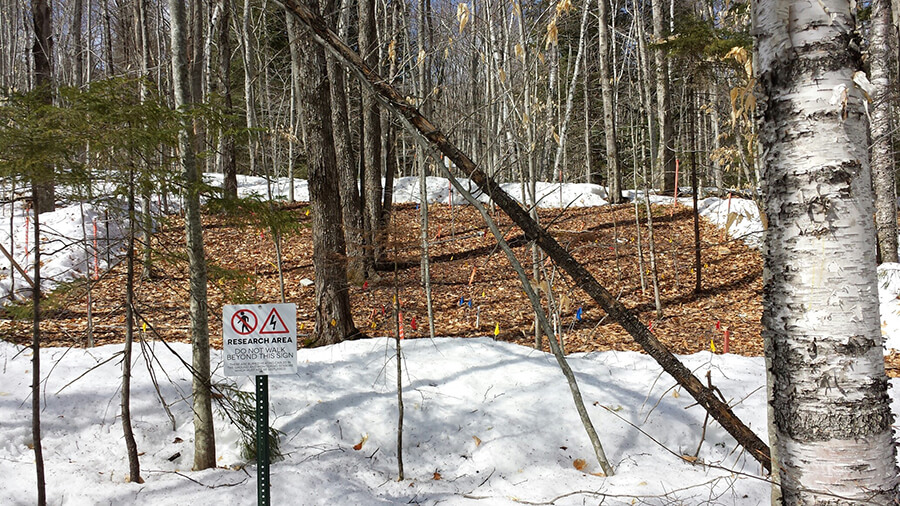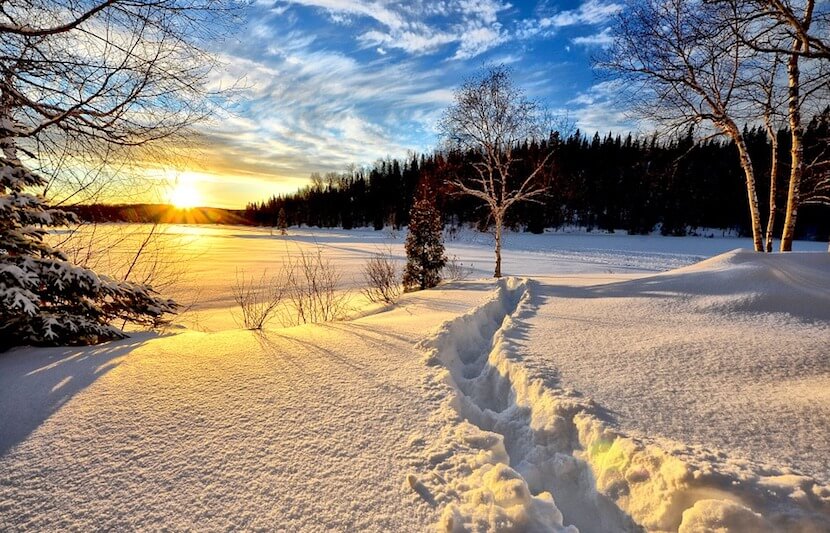Climate change could drastically reduce winter snowpack in forests across the northeastern United States, creating a cascade of problems for the ecosystems of affected forests as well as human populations living in those areas, according to a new study.
Drawing on over 60 years of data showing winter snowpack declines at Hubbard Brook Experimental Forest in New Hampshire, researchers at the Graduate Center of the City University of New York and Boston University project up to 95 percent reduction in forest area covered by deep, insulating snowpack across the northeastern United States by the year 2099.
The forest area in the northeast that is currently covered by deep snowpack during the winter months could shrink from 33,000 square miles today to just 2,000 square miles, an area about one-fifth the size of Vermont, by the end of the 21st century.
The researchers found that these changes could result in a 40-55 percent decline in sugar maple growth rates in areas that experience significant snowpack declines.
If borne out, these projections would cause major disruptions in the ecology, animal life and human activities in and around 85,000 square miles of northern hardwood forests in the United States and Canada.
The study is published in Global Change Biology.
Importance of deep snowpack
Winter snow cover — particularly deep snowpack — serves important functions in northeastern forest ecosystems.
Every winter, snow covers these forests like a blanket. This thick layer helps many species of plants, animals and insects cope with brutal subzero temperatures. It also helps to maintain the health of the forests’ trees and soil by preventing damaging frost from penetrating into the ground and harming roots and organisms living in the soil.
“We know that tree roots and soil-dwelling organisms such as microbes, invertebrates (e.g., arthropods) and perhaps even vertebrates like salamanders and some frogs rely on the deep snowpack to insulate them from subfreezing air temperatures in winter,” said Andrew Reinmann, an assistant professor and researcher with the Environmental Science Initiative at the Advanced Science Research Center at the Graduate Center, CUNY, and with Hunter College’s Department of Geography, and the study’s first author.
“The loss of the snowpack can increase exposure of tree roots and these organisms to soil freezing,” he continued. “From our work and the work of others, we find that soil freezing damages tree roots, increases losses of nutrients from the soil, reduces arthropod abundance and diversity, and can impair overwinter survival of seedlings of some tree species.”
Reinmann noted that soil freezing has a cascading effect on forest health. By damaging roots and changing soil chemistry, it also impacts leaf chemistry and the growth of branches. The health of the forest broadly declines as key nutrients, such as nitrogen, wash out of the soil and insect communities experience population and diversity loss.
The study
The new study, conducted by Reinmann with Eleonora M.C. Demaria of the Southwest Watershed Research Center along with Pamela H. Templer and Jessica R. Susser from the Department of Biology at Boston University, suggests that the ecosystem response to snowpack declines could hinder the growth rates of 40-55 percent of sugar maple trees in northeastern forests.
To understand how the removal of deep snowpack affects tree growth, the researchers removed snowpack from plots of the Hubbard Brook forest and analyzed the effect on tree health in those areas over five years.

They found that without this natural buffer, soil frost depth reached over 30 centimeters in areas where snow cover had been removed, compared to roughly 5 centimeters in snow-covered areas.
Using a specialized hollow drill bit called an increment borer, the researchers removed straw-sized wood cores from sugar maple stems. Viewed under a microscope, these wood cores showed the trees’ annual growth rings and allowed the researchers to track the effects of snowpack removal in real time.
The researchers found that after just two years, the sugar maples grew up to 40 percent more slowly. For the remaining three years, their growth rates remained 40-55 percent lower than in areas covered by deep snowpack.
Therefore, any significant decline in deep, insulating snowpack can cause serious damage to the ecosystem.
The researchers say snowpack declines could reduce growth rates in the northern hardwood forest region by 20 percent just through its impact on the trees. Even that likely underestimates the total effect on forest growth because it doesn’t account for root damage caused by soil freezing.
While some previous studies suggests that warming growing season temperatures could help offset the damage caused by reduced snowpack, the researchers believe that this is unlikely.
For the past five years, the researchers have studied tree growth and root damage under warmer conditions as part of the Climate Change Across Seasons Experiment. They use buried heating cables to warm forest soils by 9 degrees Fahrenheit during the growing season from April to November. During the winter, the researchers remove snow from the area and continue warming the soil with heating cables, effectively inducing soil freeze-thaw cycles. So far, they have found that the damage caused by these freeze-thaw cycles was not offset by warmer soil temperatures.
The impact of snowpack decline
In addition to affecting the forest ecosystem, deep snowpack declines would directly impact the lives of many people residing in these areas.
“The maple products industry, timber industry, tourism and recreation industries rely pretty heavily on snow and cold winters,” said Reinmann. “We show in our work that declines in snowpack and increases in soil freezing adversely impacts sugar maple trees, which are at the heart of several of these industries.”
Reinmann cited the potential effects that declines in sugar maple trees could have on the maple syrup industry, as shorter and more variable winters reduce the length of the sap production season and reduce quality and quantity of maple.
The ski industry, central to the livelihood and local economy of many small northeastern towns, would also be hit hard. A low-snow winter can cost the ski industry over $1 billion and 17,400 jobs compared to an average season.
Reinmann noted that while the ski industry can buffer some declines in snowpack by producing snow, it is expensive to do so and still requires cold weather.
“Short of greatly reducing carbon dioxide emissions and mitigating anthropogenic climate change, there does not seem to be much we can do,” he said.
“Culturally and economically, warming winters will likely have negative impacts on the livelihoods of many people living in the region, as well as the people that flock there for tourism and recreation.”



